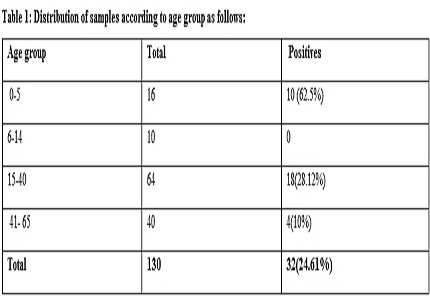Laboratory surveillance of H1N1 swine influenza A virus infection in patients with severe acute respiratory illness (SARI)-an institutional study
Abstract
Introduction: Lower respiratory tract infections (LRTI) are a leading cause of death in developing countries and are also third leading cause of death worldwide. Influenza is an acute viral and highly contagious respiratory infection causing significant morbidity and mortality. The 2009, swine flu pandemic is caused by a novel reassorted H1N1 subtype of H1N1 influenza A virus.
Objectives: The present laboratory study was conducted for the active surveillance of H1N1 swine influenza A virus infection in type C category of patients with Severe acute respiratory illnesses (SARI).
Materials and Methods: In clinically suspected cases of swine flu, a total of 130 deep nasal / throat swabs were collected and inoculated into viral transport medium (Himedia labs ) and In the reference lab, samples were tested with Real time reverse transcriptase PCR for universal influenza A (inf A), swine influenza A (SWinfA) and swine H1 (SW H1) probes.
Results: Among the total 130 samples, 32 are showing positive by Real time RT-PCR with a prevalence of 24.61%. In 0-5 age group, 10 were positive with prevalence of 62.5%. In total 66 were males with 12 positives (18.18 %), 64 were females with 20 positives (31.25%).
Conclusion: H1N1 influenza A is a potentially infectious disease, which spreads by droplet infection, so laboratory based surveillance is necessary to know the intensity of infection, seasonal trends and epidemiological factors like variations according to gender, age and region; which is also helpful for local health authorities to take the appropriate control measures.
Downloads
References
2. Badar N, Bashir Aamir U, Mehmood MR, Nisar N, Alam MM, Kazi BM, Zaidi SS. Influenza virus surveillance in Pakistan during 2008-2011. PLoS One. 2013 Nov 8;8(11):e79959. doi: 10.1371/journal.pone.0079959. eCollection 2013. [PubMed]
3. Shashi S, Gaurav J, Paban Dash K, Parida MM (2015) Laboratory Investigation and Molecular Epidemiology of H1N1pdm Virus 2012-2013 from India, J Phylogen Evolution Biol 3: 139. doi:10.4172/2329-9002.1000139. [PubMed]
4. Dandagi GL, Byahatti SM. An insight into the swine-influenza A (H1N1) virus infection in humans. Lung India. 2011 Jan;28(1):34-8. doi: 10.4103/0970-2113.76299. [PubMed]
5. Centers for Disease Control and Prevention (CDC). Update: novel influenza A (H1N1) virus infection - Mexico, March-May, 2009. MMWR Morb Mortal Wkly Rep. 2009 Jun 5;58(21):585-9.
6. Ministry of health and family welfare, India .information of swine flu ,new Delhi MOHFW,available from http:// www.mohfw.nic.in /swine flu .htm accessed on November 18,2011.
7. World health organization .world now at the starting of 2009 influenza pandemic .statement to the press by WHO, director general.Dr.margaret chan,available from :http:/who.int/media centre/news/statements /2009/h1n1_ pandemic _phase 6 _ 2009 011/en/index .html,accessed on November 18,2011.
8. World health organization. H1N1in post pandemic period .available from: http:/who.int/media centre/news/statements /2010, H1N1_VPC_20100810/en/index .html, accessed on Nov, 18, 2011.
9. Influenza (seasonal), World health organization. April 2009, available from http:/who.int/media centre/fact sheets /fs211/en/accessed on April 16, 2012.
10. Singh M and SharmaS, An epidemiological study of recent outbreak of influenza A H1N1 (swine flu) ,in western Rajasthan region of India .JMed Allied Sci.2013;3(2):48-52.
11. Garten RJ, Davis CT, Russell CA et al. Antigenic and genetic characteristics of swine-origin 2009 A(H1N1) influenza viruses circulating in humans. Science. 2009 Jul 10;325(5937):197-201. doi: 10.1126/science.1176225. Epub 2009 May 22.



 OAI - Open Archives Initiative
OAI - Open Archives Initiative


